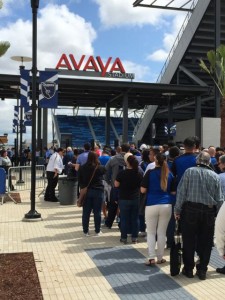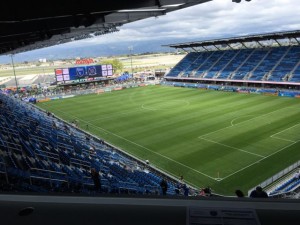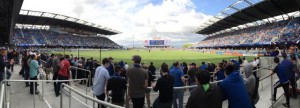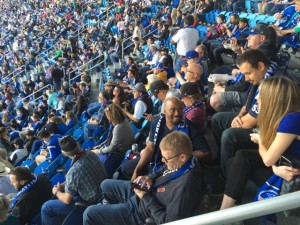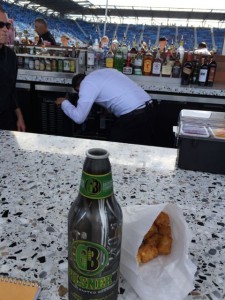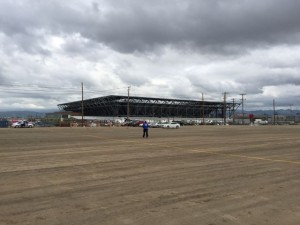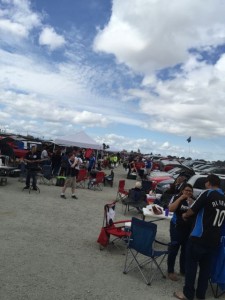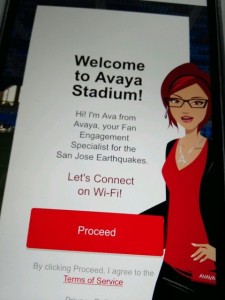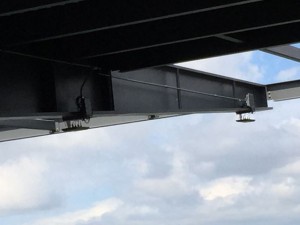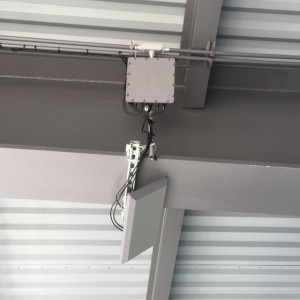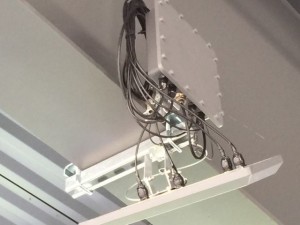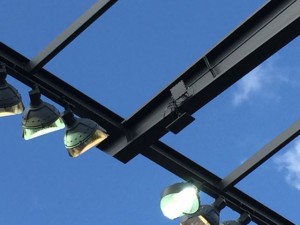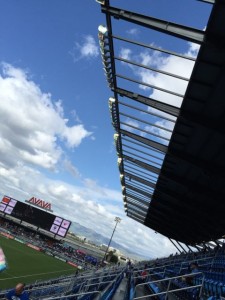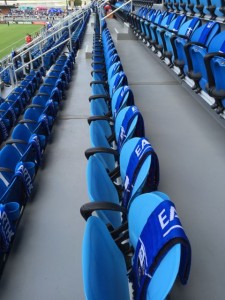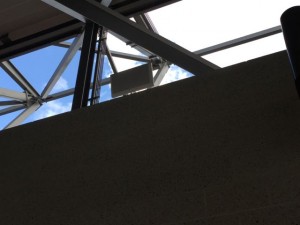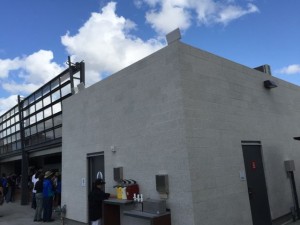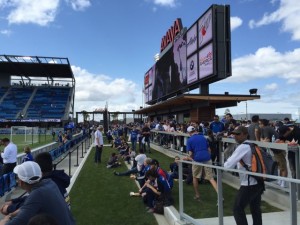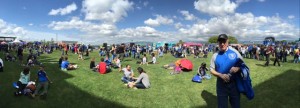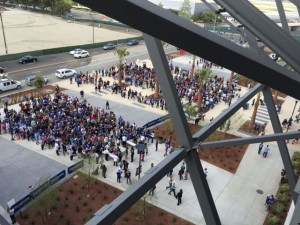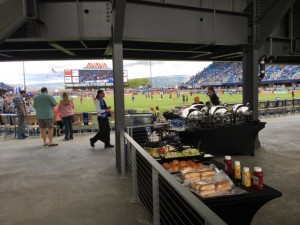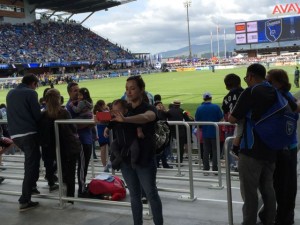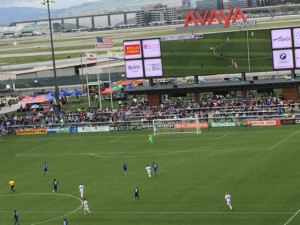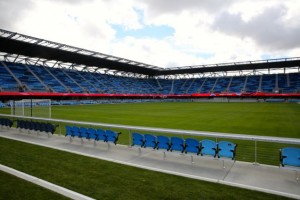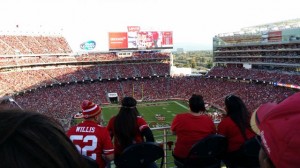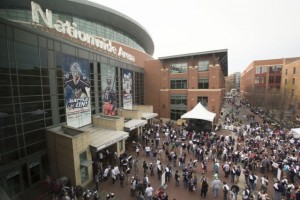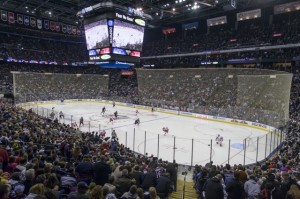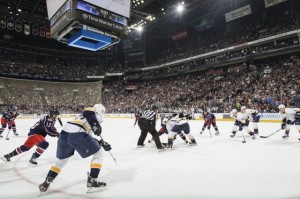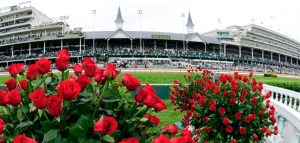Mobile Sports Report visited Avaya Stadium for its “official” debut, Sunday’s San Jose Earthquakes’ MLS season home opener against the Chicago Fire, which ended in a 2-1 San Jose victory. But the team on the field wasn’t the only winner, as fans seemed to be smiling and enjoying every part of the new $100 million venue, from its huge end-zone bar and its close-to-the-field seats, to the pre-game picnic area with food trucks, music, and space for kids to run around. Well-planned parking and traffic operations seemed to cause few problems, with most fans finding their way to their seats in the new park in time for the just-after-4 p.m. kickoff.
If my unofficial walk-around testing was any true barometer, my guess is that the only problem some fans might have had Sunday was trying to connect to the Internet to post the thousands of selfies I saw being taken with smartphones. With almost zero cellular communication inside the stadium, and very low Wi-Fi readings in much of the seating bowl, my tests lead me to conclude that while the stadium is wonderful right now for watching futbol, its wireless connectivity is still a work in progress but one that should get better soon when the planned neutral-host DAS from Mobilitie gets installed and becomes operational.
Parking and traffic a breeze
Since I arrived early and had an employee-lot parking pass (thanks to the Earthquakes for the media pass and parking) I didn’t encounter any traffic at all either in my drive down 101 or on the streets leading to the stadium. Approaching from the north on 6-lane wide Coleman Avenue, there was very clear signage for each of the parking lots, and no backups in sight at 2 p.m., two hours before the scheduled start.
Since it’s about one-fourth the size of its neighbor to the north, the San Francisco 49ers’ Levi’s Stadium, Avaya Stadium probably won’t have the same kinds of transit and parking issues that plagued Levi’s during its inaugural season. It also seems like the Avaya Stadium location is a much better setup for getting in and out of the stadium, with the wide Coleman Avenue and the huge dirt lots directly adjacent to the venue. Walking past some early bird tailgaters I was at the stadium gates in a couple minutes. In both the employee lot and the closest regular parking lot, I couldn’t get a Wi-Fi signal at all but cellular connectivity was pretty good (7+ Mbps on Verizon 4G LTE), as I could see several large cell towers around the edges of the lots. Even with a packed parking area, fans should still be able to get a signal on their way in.For my early entry time I didn’t see any issues with stadium entry technology, but the lack of metal-detector gates (security personnel used handheld wands to scan each fan as they entered) might be something that slows down the process of getting into the stadium. I did notice larger lines around 3:30 p.m., but like anywhere else the entry procedures will likely only improve with time.
Before coming to Avaya Stadium I downloaded the new team app, which seemed a little bare-bones. Since I didn’t have a ticket I couldn’t test the digital season-ticket integration, but I was able to use the directions to the stadium feature and the stadium map, which provides a helpful picture-view of all amenities that can be found in the U-shaped seating area as well as the open-air bar. The map is interactive, giving you a description of each amenity (bathrooms, team store, etc.) when you touch the associated icon. As of yet there is no way to use the app to pay for concessions or to view any live or archived video. Like other stadium apps, including Levi’s, the Avaya Stadium app will likely grow in functionality over time.
Wi-Fi performance: Great on the concourses, weak in the seats
Just after finding my “exterior press box” seat in possibly the “worst” part of the stands — the upper northwest corner — I quickly saw how Avaya Stadium was going to deliver its Wi-Fi signals to the seating area, by looking up at the metal beams supporting the awnings that are the open-air “roof.” On each beam I could see anywhere from two to three Wi-Fi access points, all targeted directly down at the seats below them. The Avaya Wi-Fi deployment has no under-the-seat APs or any handrail APs that I could see, but there are lots of other APs visible on top of concession stands and other places around the single, ground-level concourse. There are also some APs attached to the huge bar area that spans across the open east end of the stadium. Gaining access to the network was a snap, done by just clicking on the “proceed” button that popped up on the splash screen that appears after you select the “GOQUAKES” SSID on your device. There was no login credential or password required.
How did the network perform? Before the stadium filled up, my rooftop seat had a signal between 5 and 7 Mbps on the download and upload sides, a figure that would decline steadily as the day progressed. Walking down the steep stairs into the largely empty seating bowl, the Wi-Fi speeds decreased, with a couple readings in the 2-3 Mbps download range near the lowest row of seats.Hungry because I hadn’t had lunch, I ventured out past the huge end-zone bar to a large grassy area that was lined with food trucks and filled with soccer fans having impromptu picnics with lots of kids running around. There were various booths for soccer clubs and from sponsors, as well as a band, which made the area seem (in a good way) more like a county fair than a pro sporting event. I couldn’t get a Wi-Fi connection out on the lawn, but I was able to get a good cellular signal, around 8 Mbps, on my Verizon device (an iPhone 6 Plus). Feeling thirsty I headed to the bar, where Wi-Fi kicked in again, with one signal of 22 Mbps down and 17 Mbps up.
Starting to fill up here at @AvayaStadium and found better wifi: 20 mbps at outside bar, 15 mbps in lower concourse pic.twitter.com/BqvPjyjOvt
— paulkaps (@paulkaps) March 22, 2015
Heading back through the now-crowded concourse toward my seat, I stopped and got a Wi-Fi reading of almost 16 Mbps down and 9 Mbps up, in the middle of a large throng of fans. But I wouldn’t hit that mark again the rest of the afternoon, which makes me wonder how well the network held up under a full-house load.
Up close and personal areas a hit with fans
Since I’d never been to a professional soccer game before I decided to soak in as much fan flavor as I could. At Avaya Stadium I headed down to the space behind the west end zone, in the closed end of the stadium, where there are several rows of standing-room only spaces where some of the loudest fans congregated (there was one group with a band, and many flags). Directly above the standing section was a seat section reserved for the team’s ardent followers, many of which spent the entire game standing, cheering, chanting and singing. Down below, I was fortunate enough to be close to the action and saw the Earthquakes’ first goal in their new home arena, a double header off a corner kick.And though I was able to catch the score on video, because there was basically zero Wi-Fi signal there (I was directly underneath the bottom row of the stands) I wasn’t able to immediately post it to Twitter or Vine. Not that I cared that much, since it was fun to be swept up in the chanting and cheering and streamer-tossing that followed the goal. So even if I wasn’t connected wirelessly, I was certainly connected to the fans right around me — which, I think, is what Avaya Stadium is all about.
Quakes goal! pic.twitter.com/Jl2opi0dcS
— paulkaps (@paulkaps) March 22, 2015
I’m no wireless engineer, but I was hardly surprised that the Wi-Fi signal in the seats wasn’t strong; looking way up at the APs on the roof, they seem too far away to be able to provide a high level of connectivity to the seats below, especially the ones closest to field level. Other stadiums we’ve covered in the near past have already either started or are making plans to increase the Wi-Fi APs at field level, since that’s one of the toughest areas to put an AP.
But like in the standing section, I’m not sure that Wi-Fi connectivity is a big deal for fans in the seats during the game action, which in case you’ve not watched soccer, has no breaks like timeouts or inning changes. I’m generalizing here but I think that the continuous-flow of soccer action inherently results in fans who simply watch the game instead of taking breaks to check their phones (Mark Cuban, here’s your sport!). So maybe the expense of bringing Wi-Fi to all the seats at Avaya Stadium isn’t justified.
That said, it seemed like during halftime there were a lot of people looking at devices in their stadium seats, but I didn’t hear any howls or complaints or see any obvious frustration. I do know that at my seat on the stadium’s top walkway (which can get very very very windy in the late afternoon) the Wi-Fi signal was weak the whole game, never registering more than 1 Mbps on the download side from the start of the game through the second half.But again, this is just one phone and one person, a person who was also walking around a lot and connecting to multiple APs, a factor that sometimes makes network connections inconsistent. I did find that turning Wi-Fi off and on again helped get a better signal; when we hear back from the stadium network team we’ll ask if the network has been optimized for roaming connections. I did notice that the beer stand on the top deck just behind my “press box” seat was using cell phones and a payment-device gizmo to take credit card payments; when I asked the staffer running the stand she said she’d been taking payments all game using the regular Wi-Fi and hadn’t had any connectivity issues. So, the connectivity mileage may vary.
DAS to the rescue
Though team executives have talked a lot about the stadium’s networking plans, it would be better for fans right now to have a more realistic estimate of what is going on, and when future enhancements like video and food ordering will become a reality. Some improvement will happen in a big way when Mobilitie gets the neutral-host DAS up and running, since many people never think of joining a stadium Wi-Fi network, they just pull out their phones and hope for the best. With advanced cellular in the building, the connectivity loads will be shared between cellular and Wi-Fi, increasing overall capacity. Sunday, I wasn’t able to get either an AT&T 4G device or my Verizon phone to even register with Speedtest.com to get a figure anywhere inside the stadium using a cellular-only connection. While most fans might have been able to send text messages or get regular voice calls, it’s a good guess that many like me were stymied trying to do simple data tasks like post messages to Twitter. It will be interesting to see what the network folks from Avaya Stadium say when they give us the opening-day report.
In the end, my first impression from a wireless point of view is that Avaya Stadium has a basic, average level of connectivity for a new stadium, with enough reasons to believe it’s going to get better over time. I’m also cutting them some slack since the technology supplier for the venue changed wholesale last year when Avaya came in as a title sponsor, leaving just a few short months for Avaya to get its own gear in the building and in working order. Again, I’m no engineer but I did see things like electrical tape holding some antenna connections in place, the kind of stuff you don’t expect to see in a professional stadium deployment.And while the connectivity didn’t particularly stand out as awesome, it also was good enough in enough places to make sure there wasn’t the dreaded “no signal” issue that could have soured things for lots of fans. In the end, there was so much to like about the facility — even in my top-row seat I felt close to the action on the field — that it’s hard to call the day anything short of a smashing success, especially if you are a Bay area soccer fan who’s had to endure sub-par stadium experiences in the past. Those days are gone, and Avaya Stadium should be a fast favorite place going forward.
LOTS OF PHOTOS BELOW! Click on any picture for a larger image. Credit all photos: Paul Kapustka, MSR.

